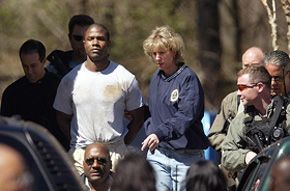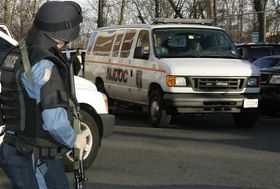It doesn’t matter if you’re transporting one prisoner or many, they are all dangerous and pose a threat to everyone involved. Here, we’ll take a look at some strategies for conducting special (or “high profile”) prisoner movements where the possibility of escape or ambush is high. High-profile transports are tricky to plan, because there are a lot of moving parts involved. As the number of team-members and agencies grow and the logistics become more complex, the likelihood of miscommunication rises.
Coordinating with multiple jurisdictions is like an extended family trying to raise one kid. Multiple voices of authority can cause dissention and power vacuums, especially if one leader is injured during the process, and it’s not clear who is supposed to step up and fill the gap. Teams must take these variables into consideration and have a plan in place before a special transport is necessary.
Training with other agencies
Interagency training for high-profile transports is critical so that everyone’s reading from the same sheet of music, as they say. But just because everyone knows interagency training is important, that doesn’t mean it always happens. There are a few potential reasons for this: First, the correctional world can be slow to implement changes unless a situation (and probably not a good one) arises that necessitates that change.
|
Second, many agencies are entrenched in a mindset of “this is the way we’ve always done it.” Branching out and investing time and resources into interagency training just isn’t on the cultural radar or administrative “to-do list” of most departments. But it should be.
Selecting your teams
Having a select team of train professionals in place will greatly assist you in conducting your prisoner movements. If you are doing a “pre-planned movement,” you’ll have advanced time to select, train and rehearse your movement and strategies with your team. On the other hand, an “emergency” or “hurried” movement” is usually based on an immediate need to relocate a prisoner and separate him from the general population.
Each team needs to be well-equipped and crossed-trained to perform all duties discussed below.
Movement team
Everybody — all officers and all staff involved in movement — are part of the “movement team.” (The number of officers on your team will vary based on manpower, schedules and other shifting plan factors.) From here, sub-teams are formed based on their primary functions: security, transportation, decoy, cover and isolation.
In order to reduce the possibility of security breaches, sensitive information should be strictly limited; only the minimum number of officers and staff should be privy to the logistics of the plan. Passwords, hand signals, color codes and unscheduled briefings among those “in the know” can be used to help keep the plan a secret.
At the final briefing, each team will be identified to ensure security of the movement.
Security team
The security team leader is responsible for the safety and wellbeing of their team and of the inmate being escorted. The “point” or “lead” officer is positioned to the front of the team to help clear pathways, negotiate unforeseen obstacles and generally to be the eyes of the movement team.
The right and left flank officers are positioned to the immediate right and left side of the principal for side security. The rear security will be positioned to the rear of the principal and provide security from any rear attacks; they will also substitute for an escorting officer if this position is terminated during an attempt to escape. In addition to this there will be an escorting officer who is directly responsible for the inmate during movement. The escorting officer is recommended to be same sex and designated from the movement team.
Depending on the level of visibility and attention you want, uniforms and weapons suggested are as follows: tactical-uniformed personnel with appropriate duty gear, ballistic helmets, hard body armor, communications, primary and secondary weapons.
Depending on the circumstances, consider assorted non-lethal weapons for high visual deterrent, or more casual clothing for lower key movements. The security team leader will assign a team member to stay with the individual being transported. The team leader will be in the primary escort vehicle.
Transportation team
The transportation team is responsible for the initial pick-up to the location, movement to the location, pick up from location and return to the final security point. Team members include a driver and assistant driver for each vehicle, plus an alternate driver and vehicle security for all points of entry on vehicle.
|
Each member of the transportation team will be licensed to operate all vehicles used. Primary, secondary and alternate vehicles will be used for both training and movement, and will be designated on day of movement. Another suggestion is to have a sleeper riding on the bus to help with intelligence and additional security.
Uniforms and weapons suggested are tactical uniformed personal with appropriate duty gear, ballistic helmets, hard body armor, communications, primary and secondary weapons and assorted non lethal weapons. Team members will wear clothing that helps them identify one another, and ideally to help them blend in with their surroundings.
Decoy team
The decoy team is set up to work as a decoy for the security team and inmate, approximating their height, weight and appearance. Usually the decoy team will take alternate routes or use other high-visibility movements to draw attention away from actual inmate and escort. To enhance the overall security of the mission (and when practical) it’s recommended that the decoy teams not be made known to the security and transportation teams until the final briefing.
Tactical-uniformed personnel with appropriate duty gear, ballistic helmets, hard body armor, communications, primary and secondary weapons as well as assorted less-lethal weapons are highly recommended. Clothing for the decoy team should, of course, be chosen to match the clothing of the team they are providing a decoy for.
Cover team
The cover team consists of high-level observation teams, ground teams and a perimeter team. The high-level observation teams can be manned with a marksman, observer and sniper working in teams of three. They will be in charge of covering movement for the security team and during “hand-offs” between security and transportation teams.
Ground teams are the “mixers of the bunch.” These teams are comprised of males and female officers who will mix with the crowd, camera crews, protectors, and other passive/combative individuals they may confront.
The perimeter team forms a security circle that will contain the movement of the operation. Uniforms and weapons suggested are: Plainclothes or non-uniformed personnel with appropriate concealment gear, soft body armor, communications, plus primary, secondary and less-lethal weapons.
Controlling movement
Transportation routes are by their very nature porous, and if they’re not secure, they can put you in a lot of danger. Controlling all movement within this operation is vital, and it begins the first moment you move the inmate from his holding point to the first security checkpoint. (A “checkpoint” is a location within your operations plan which has been secured. It’s a place you can fall back to if need be, a place where you control all points of entry and exit.)
Primary, secondary and alternate transportation routes will need to be driven at different times of the day in order to determine travel times, traffic, cross streets, ambush potentials and other danger points. During this process you will get a better understanding of the types of vehicles or other types of modes of transportation you may need for this movement.
Lead and tail vehicles will be used for additional security, and in case of an ambush may be used as another movement vehicle for the principal. Training for this movement needs to be simulated in all kinds of weather and traffic situations in case there are last-minute problems, e.g., car accidents, blown tires, construction or traffic detours.
Establishing “fall-back” or “extraction” points along the route may be necessary to help evacuate the principal from the area during an ambush.
Know your route
Once you’ve established the primary route, get to know it. You should walk this route and fully document it. Take pictures. Videotape everything around it. Survey all possible threats such as elevated areas, large trash bins and abandoned or rental vehicles along the roadway. Include buildings, high-rise apartments, vacant buildings and construction crews.
Once you’ve identified the danger areas, you’ll need to practice your response to attacks and ambush areas. Leave nothing to chance. Remember: If you can think about it, so can they.
Ambushes on convoy vehicles warnings
A timed attack on both the lead and tail vehicle is usually executed simultaneously. This blocks the middle of the convoy from escaping easily, and provides a giant distraction; a probable attack on the principal vehicle would then be conducted by using a ram vehicle or shooting out the tires or something to disable the principal vehicle.
Smoke, loud sounds and chaos are magnified to help present the element of their surprise, even the use of friendly and innocents. They may have a cover team of their own providing fire support.
When the convoy is secured, they will attempt to remove the principal at this point by either using other masked vehicles like emergency or public safety vehicles, boats if near water ways, helicopters or even underground modes, depending on the location of the ambush. Remember: Not everyone wears black hoods and masks.
You will be able to help prevent these types of attacks by conducting your own rapid emergency responses to these attacks after you have identified these danger areas during your surveys.
If you don’t have a plan, then you plan to fail.
If all of your attempts to protect the principal fail, you’ll have to go into what I call the “hunting retrieval mode.” In this mode, quick thinking and fast action are mandatory. The first twelve hours are the most critical.
- Remember, regardless of whether or not the inmate wants to go with his kidnapper, he will most likely change his physical appearance – this can be anything external, including hair and eye color, clothing and even facial features, e.g., the nose, ears and cheek bones.
- Think ahead. Plan what type of clothing the inmate will be wearing. Here are a few suggestions:
- Use infrared markings on the inside of their clothing (shoes, shirt collars, pants) so when they do remove the clothes, additional markings will still be visible using a special light for a longer time period.
- Use electronic technology is to tagging clothes or other personal effects, e.g., prescription glass or frames. Better yet, try internal tagging. Tagging the inmate internally is another option, like ear lobes, forearm, ear and neck line. I personally like tagging tooth fillings when possible.
- Keep updated pictures and addresses of the inmate’s family, friends or associates handy. Shut down all possible pick-up and extraction points, such as waterways for boats, landing strips for airplanes, underground routes, train or bus stations, high areas for use of helicopters, etc.
- Have all contact numbers of agencies who will be responsible for the capture (if needed) handy and ready to go. Usually the first 12 hours are the most critical for tracking the principal after being kidnapped.
Good luck out there, and remember, be safe, be strong and stay alive!
Dave Young is the Director of Specialized Programs for Northcentral Technical College and the Director of Training for Redman Training Gear, now part of the Police1 Training Network. He is also a training advisor for Police1.com. Dave graduated from his first law enforcement academy in 1985, and now has over 20 years of combined civilian and military law enforcement and training experience. He was a sworn corrections and law enforcement officer in the state of Florida and has served as a gate sentry, patrol officer, watch commander, investigator, Special Reaction Team (SRT) member, leader and commander in the United States Marine Corps.














